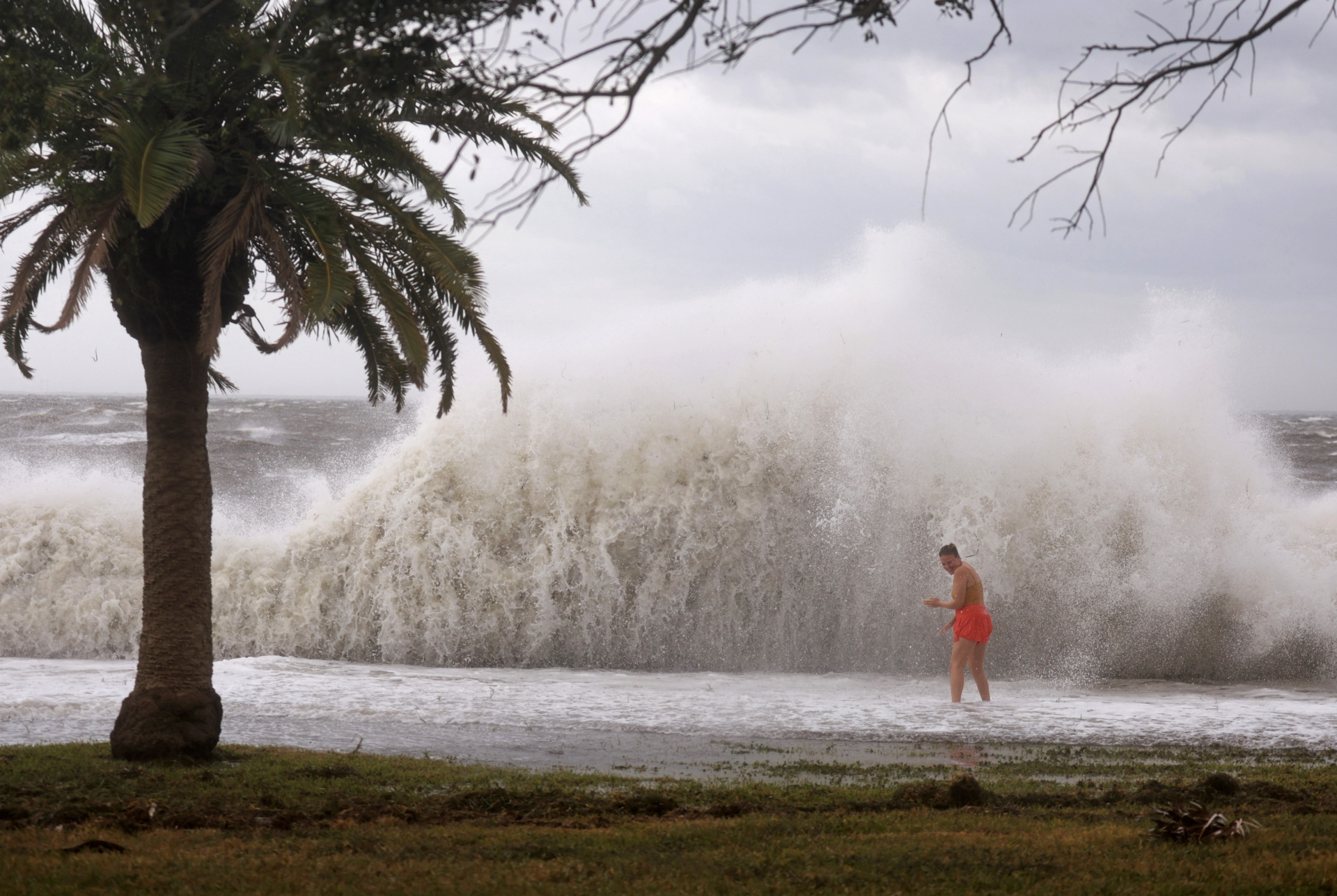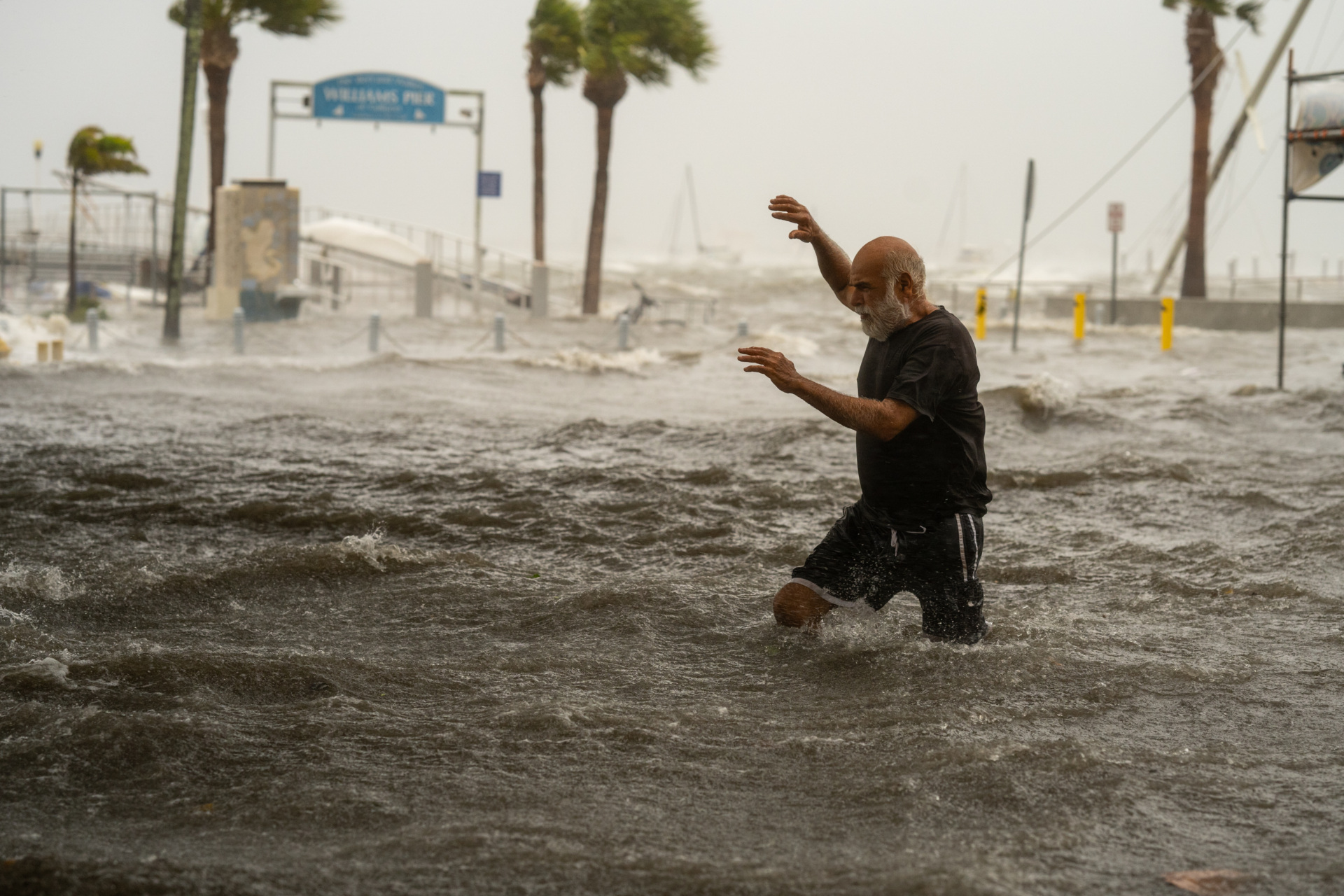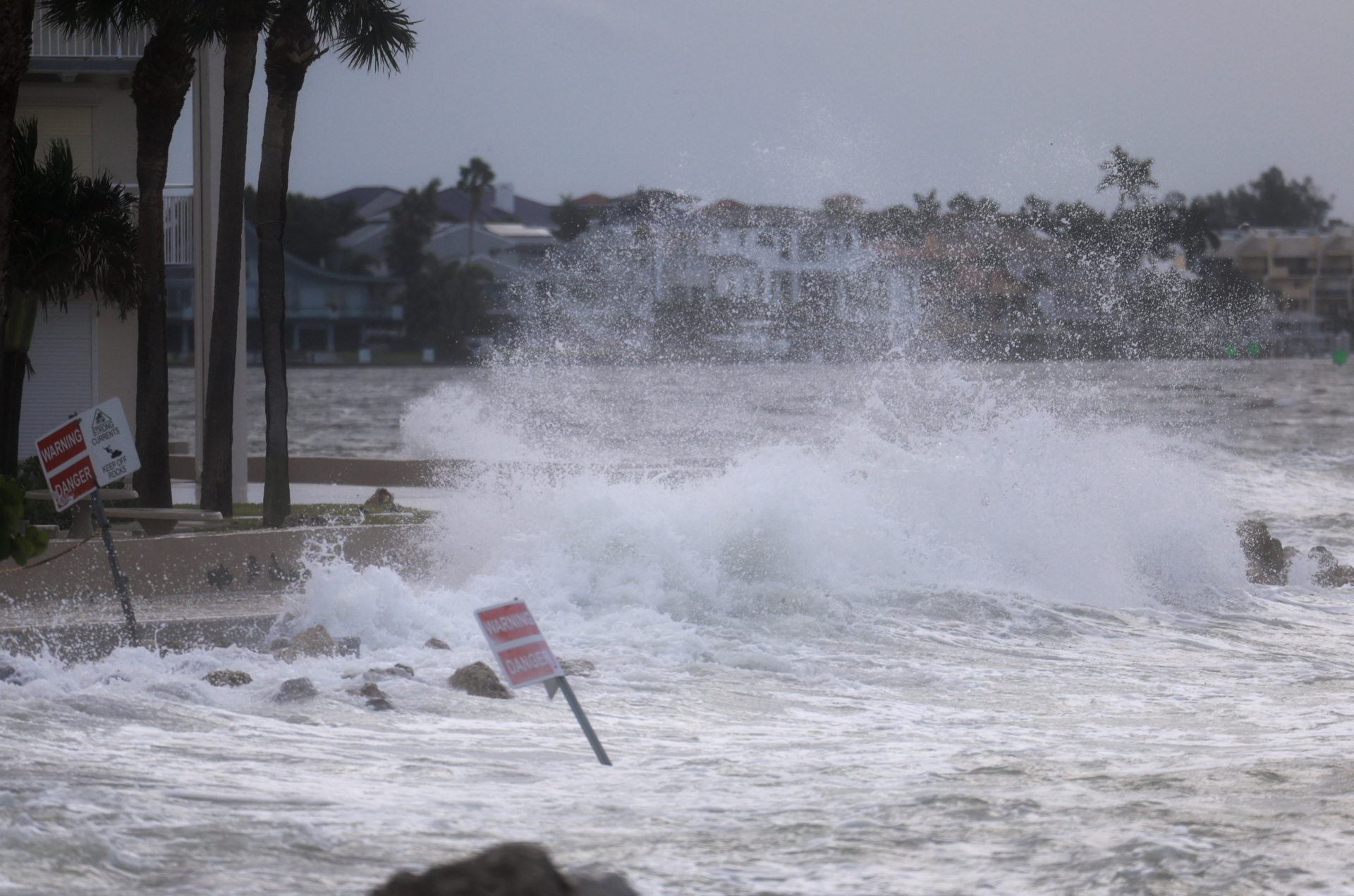PHOTOS: Tropical Storm Helene Lashes the South, Leaves Millions Without Power Hillsborough County Sheriff's Office /TMX
CRAWFORDVILLE, Fla. (AP) — Authorities rescued people trapped by floodwaters and more than 3 million customers were in the dark across much of the southeastern U.S. as Hurricane Helene weakened to a tropical storm over Georgia early Friday after making landfall overnight in northwestern Florida as a Category 4 storm.
Helene came ashore amid warnings from the National Hurricane Center that the enormous system could create a “nightmare” storm surge. There were at least four storm-related deaths.
Video on social media sites showed sheets of rain coming down in Perry, Florida, near where Helene made landfall, and siding being torn off buildings. One local news station showed a home that had flipped over. The community and much of surrounding Taylor County were without power.
In Citrus County, some 120 miles (193 kilometers) south of Perry, first responders were out in boats early Friday to rescue people trapped by the flooding.
“If you are trapped and need help please call for rescuers – DO NOT TRY TO TREAD FLOODWATERS YOURSELF,” the sheriff’s office warned in a Facebook post. The water may contain live wires, sewage, sharp objects and other debris, they posted.
With maximum sustained winds of 70 mph (110 kph) , Helene continued to weaken while moving farther inland over Georgia. The storm was about 40 miles (65 kilometers) east of Macon and about 100 miles (165 kilometers) southeast of Atlanta, moving north at 30 mph (48 kph) at 5 a.m., the hurricane center in Miami reported.
“We expect it to weaken further. It’s going to turn northward and turn northwestward and eventually move into Tennessee and Kentucky, and merge with a funnel system up in that area,” said Jack Beven, a senior hurricane specialist at the National Hurricane Center.
The storm should continue to weaken Friday afternoon, with winds dropping below 40 mph (64 kph), but it will still produce widespread heavy rain over the Appalachian Mountains with the possibility of mudslides and flash flooding, Beven said.
The hurricane center said Helene roared ashore around 11:10 p.m. Thursday near the mouth of the Aucilla River in the Big Bend area of Florida’s Gulf Coast. It had maximum sustained winds estimated at 140 mph (225 kph). That location was only about 20 miles (32 kilometers) northwest of where Hurricane Idalia came ashore last year at nearly the same ferocity and caused widespread damage.

Tanner Flynn stands in shallow water near crashing waves as Hurricane Helene passes offshore on September 26, 2024, in St. Petersburg, Florida. (Photo by Joe Raedle/Getty Images)

A man crosses a storm surge flooded area on the coast of Gulfport, Florida, as Hurricane Helene passed through the Gulf of Mexico to the West on September 26, 2024. (Photo by Thomas Simonetti for The Washington Post via Getty Images)

A capsized boat washes ashore as Hurricane Helene churns offshore on September 26, 2024, in St. Peteersburg Florida. (Photo by Joe Raedle/Getty Images)

The Gulf of Mexico’s water pushes up against the beach as Hurricane Helene churns offshore on September 26, 2024, in St. Pete Beach, Florida. (Photo by Joe Raedle/Getty Images)

Waves from the Gulf of Mexico crash on shore as Hurricane Helene churns offshore on September 26, 2024, in St. Pete Beach, Florida. (Photo by Joe Raedle/Getty Images)

The streets are flooded near Peachtree Creek after hurricane Helene brought in heavy rains over night on September 27, 2024, in Atlanta, Georgia. (Photo by Megan Varner/Getty Images)

The streets are flooded near Peachtree Creek after hurricane Helene brought in heavy rains over night on September 27, 2024, in Atlanta, Georgia. Hurricane Helene made landfall late Thursday night as a category 4 hurricane in the pan handle of Florida and is working its way north, it is now considered a tropical storm. (Photo by Megan Varner/Getty Images)

An emergency shelter for Hurricane Helene was set-up at Leon High School in Tallahassee, Florida, on Thursday, September 26, 2024. (Ted Richardson/For The Washington Post via Getty Images)

Charles Starling, a lineman with Team Fishel, is pelted with rain as he walks by a row of electrical line trucks staged in a field in The Villages, Florida, on Thursday, Sept. 26, 2024. Thousands of the trucks are staged by Duke Energy in preparation for damage from Hurricane Helene. (Stephen M. Dowell/Orlando Sentinel/Tribune News Service via Getty Images)
The hurricane’s eye passed near Valdosta, Georgia, as the storm churned rapidly north into Georgia Thursday night. The National Hurricane Center issued an extreme wind warning for the area, meaning possible hurricane-force winds exceeding 115 mph (185 kph).
At a hotel in the city of 55,000 near the Florida line, dozens of people huddled in the darkened lobby after midnight Friday as winds whistled and howled outside. Electricity was out, with hall emergency lights, flashlights and cellphones providing the only illumination. Water dripped from light fixtures in the lobby dining area and roof debris fell to the ground outside.
Fermin Herrera, 20, his wife and their 2-month-old daughter left their room on the top floor of the hotel, where they took shelter because they were concerned about trees falling on their Valdosta home.
“We heard some rumbling,” said Herrera, cradling the sleeping baby in a downstairs hallway. “We didn’t see anything at first. After a while the intensity picked up. It looked like a gutter that was banging against our window. So we made a decision to leave.”
In Thomas County, Georgia, where residents had been under a curfew, the sheriff’s office said it was extended until noon Friday.
“This curfew helps protect first responders and citizens of our community as conditions are still very hazardous. Please shelter in place,” the office posted online.
Helene is the third storm to strike the city in just over a year. Tropical Storm Debby blacked out power to thousands in August, while Hurricane Idalia damaged an estimated 1,000 homes in Valdosta and surrounding Lowndes County a year ago.
“I feel like a lot of us know what to do now,” Herrera said. “We’ve seen some storms and grown some thicker skins.”
Helene prompted hurricane and flash flood warnings extending far beyond the coast up into northern Georgia and western North Carolina. More than 1.2 million homes and businesses were without power in Florida, more than 900,000 in Georgia and more than 927,000 in the Carolinas, according to the tracking site poweroutage.us. The governors of those states and Alabama and Virginia all declared emergencies.
One person was killed in Florida when a sign fell on their car and two people were reported killed in a possible tornado in south Georgia as the storm approached. One person died in Charlotte, North Carolina, when a tree fell on a home as the storm blew through the area early Friday.
“When Floridians wake up tomorrow morning, we’re going to be waking up to a state where very likely there’s been additional loss of life and certainly there’s going to be loss of property,” Florida Gov. Ron DeSantis said at a news conference Thursday night.
Even before landfall, the storm’s wrath was felt widely, with sustained tropical storm-force winds and hurricane-force gusts along Florida’s west coast. Water lapped over a road in Siesta Key near Sarasota and covered some intersections in St. Pete Beach. Lumber and other debris from a fire in Cedar Key a week ago crashed ashore in the rising water.
Beyond Florida, up to 10 inches (25 centimeters) of rain had fallen in the North Carolina mountains, with up to 14 inches (36 centimeters) more possible before the deluge ends, setting the stage for flooding that forecasters warned could be worse than anything seen in the past century.
Heavy rains began falling and winds were picking up earlier Thursday in Valdosta, Georgia, near the Florida state line. The weather service said more than a dozen Georgia counties could see hurricane-force winds exceeding 110 mph (177 kph).
The storm made landfall in the sparsely-populated Big Bend area, home to fishing villages and vacation hideaways where Florida’s Panhandle and peninsula meet.
“Please write your name, birthday, and important information on your arm or leg in a PERMANENT MARKER so that you can be identified and family notified,” the sheriff’s office in mostly rural Taylor County warned those who chose not to evacuate in a Facebook post, the dire advice similar to what other officials have dolled out during past hurricanes.
School districts and multiple universities canceled classes. Airports in Tampa, Tallahassee and Clearwater were closed Thursday, while cancellations were widespread elsewhere in Florida and beyond.
While Helene will likely weaken as it moves inland, damaging winds and heavy rain were expected to extend to the southern Appalachian Mountains, where landslides were possible, forecasters said. Tennessee was among the states expected to get drenched.
Helene had swamped parts of Mexico’s Yucatan Peninsula on Wednesday, flooding streets and toppling trees as it passed offshore and brushed the resort city of Cancun. In western Cuba, Helene knocked out power to more than 200,000 homes and businesses as it brushed past the island.
Areas 100 miles (160 kilometers) north of the Georgia-Florida line expected hurricane conditions. The state opened its parks to evacuees and their pets, including horses. Overnight curfews were imposed in many cities and counties in south Georgia.
“This is one of the biggest storms we’ve ever had,” Georgia Gov. Brian Kemp said.
For Atlanta, Helene could be the worst strike on a major Southern inland city in 35 years, said University of Georgia meteorology professor Marshall Shepherd.
Helene is the eighth named storm of the Atlantic hurricane season, which began June 1. The National Oceanic and Atmospheric Administration has predicted an above-average Atlantic hurricane season this year because of record-warm ocean temperatures.
___
The Associated Press contributed to this. Payne reported from Tallahassee, Florida, and Hollingsworth reported from Kansas City, Missouri. Associated Press journalists Seth Borenstein in New York, Jeff Amy in Atlanta, Russ Bynum in Valdosta, Georgia, Danica Coto in San Juan, Puerto Rico, Andrea Rodríguez in Havana, Mark Stevenson and María Verza in Mexico City and Claire Rush in Portland, Oregon, contributed to this report.
Source link

